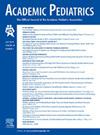巴西青少年在2019冠状病毒病大流行之前(2019年)和之后(2022年)屏幕时间行为的变化
IF 2.8
3区 医学
Q1 PEDIATRICS
引用次数: 0
摘要
目的:通过重复横断面设计,比较巴西青少年独立样本在大流行前(2019年)和大流行后(2022年)参与五种基于屏幕的活动(学习、工作、看视频、玩视频游戏和使用社交媒体/聊天应用程序)的情况;2)使用嵌套纵向队列设计检查同一时期这些基于屏幕的活动的个体内部变化。方法:收集2019年和2022年的数据,共涉及2008名青少年参与重复横断面研究,其中333人形成巢式队列样本。采用零膨胀多水平伽玛回归模型和多水平线性模型对数据进行分析。结果:在重复的横断面分析中,与2019年相比,2022年青少年每天花在学习上的时间更长(+21.3分钟;95%CI: 11.0, 31.6),观看视频(+12.8 min;95%CI: 1.1, 24.5),玩电子游戏(+22.9分钟;95%ci: 12.8, 33.1)。纵向分析显示,从2019年到2022年,学习时间平均每天显著增加(+53.8分钟;95%CI: 34.7, 72.9)和工作(+130.2 min;95%ci: 110.4, 149.9)。在这些青少年中,观看视频的时间显著减少(-26.4分钟;95%CI: -48.0, -4.9)和玩电子游戏(-28.6分钟;95%ci: -46.2, -11.8)。社交媒体的使用保持稳定。结论:与2019年相比,2022年巴西青少年的ST更高,学习、工作、看视频和玩电子游戏的时间都有所增加。纵向数据表明,从娱乐性ST向教育性和与工作相关的ST转变,这些发现强调需要有针对性的干预措施来促进平衡ST和减轻潜在的负面健康影响。本文章由计算机程序翻译,如有差异,请以英文原文为准。
Changes in Screen Time Behaviors from Before (2019) to After (2022) the COVID-19 Pandemic Among Brazilian Adolescents
Objective
Compare prepandemic (2019) and postpandemic (2022) engagement in five screen-based activities (studying, working, watching videos, playing video games, and using social media/chat applications) among independent samples of Brazilian adolescents using a repeated cross-sectional design; and 2) Examine within-individual changes in these same screen-based activities over the same period using a repeated cross-sectional study with a nested cohort.
Methods
Data were collected in 2019 and 2022, involving a total of 2008 adolescents who participated in the repeated cross-sectional study, with 333 forming a nested cohort sample. Zero-inflated multilevel gamma regression models and multilevel linear models were used to analyze the data.
Results
In the repeated cross-sectional analysis, adolescents spent more minutes per day in 2022 versus 2019 for studying (+21.3 minutes; 95% CI: 11.0, 31.6), watching videos (+12.8 minutes; 95% CI: 1.1, 24.5), and playing video games (+22.9 minutes; 95% CI: 12.8, 33.1). The longitudinal analysis revealed significant average daily increases from 2019 to 2022 in studying (+53.8 minutes; 95% CI: 34.7, 72.9) and working (+130.2 minutes; 95% CI: 110.4, 149.9). For these same adolescents, significant decreases were observed for watching videos (−26.4 minutes; 95% CI: −48.0, −4.9) and playing video games (−28.6 minutes; 95% CI: −46.2, −11.8). Social media use remained stable.
Conclusions
Screen time (ST) among Brazilian adolescents was higher in 2022 compared to 2019, with increases in studying, working, watching videos, and playing video games. Longitudinal data indicated a shift from recreational ST to educational and work-related ST. These findings highlight the need for targeted interventions to promote balanced ST and mitigate potential negative health impacts.
求助全文
通过发布文献求助,成功后即可免费获取论文全文。
去求助
来源期刊

Academic Pediatrics
PEDIATRICS-
CiteScore
4.60
自引率
12.90%
发文量
300
审稿时长
60 days
期刊介绍:
Academic Pediatrics, the official journal of the Academic Pediatric Association, is a peer-reviewed publication whose purpose is to strengthen the research and educational base of academic general pediatrics. The journal provides leadership in pediatric education, research, patient care and advocacy. Content areas include pediatric education, emergency medicine, injury, abuse, behavioral pediatrics, holistic medicine, child health services and health policy,and the environment. The journal provides an active forum for the presentation of pediatric educational research in diverse settings, involving medical students, residents, fellows, and practicing professionals. The journal also emphasizes important research relating to the quality of child health care, health care policy, and the organization of child health services. It also includes systematic reviews of primary care interventions and important methodologic papers to aid research in child health and education.
 求助内容:
求助内容: 应助结果提醒方式:
应助结果提醒方式:


